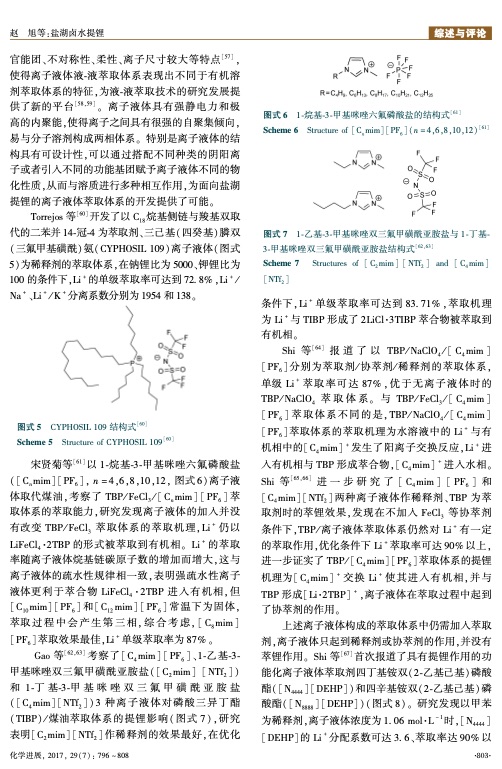
PDF Publication Title:
Text from PDF Page: 008
赵 旭等:盐湖卤水提锂 官能团、不对称性、柔性、离子尺寸较大等特点[57] , 使得离子液体液⁃液萃取体系表现出不同于有机溶 剂萃取体系的特征,为液⁃液萃取技术的研究发展提 供了新的平台[58,59] 。 离子液体具有强静电力和极 高的内聚能,使得离子之间具有很强的自聚集倾向, 易与分子溶剂构成两相体系。 特别是离子液体的结 构具有可设计性,可以通过搭配不同种类的阴阳离 子或者引入不同的功能基团赋予离子液体不同的物 化性质,从而与溶质进行多种相互作用,为面向盐湖 提锂的离子液体萃取体系的开发提供了可能。 Torrejos 等[60] 开发了以 C18 烷基侧链与羧基双取 代的二苯并 14⁃冠⁃4 为萃取剂、三己基( 四癸基) 膦双 (三氟甲基磺酰)氨(CYPHOSIL 109)离子液体(图式 5)为稀释剂的萃取体系,在钠锂比为 5000、钾锂比为 100的条件下,Li+的单级萃取率可达到728%,Li+ / Na+ 、Li+ /K+ 分离系数分别为1954 和138。 图式 5 CYPHOSIL 109 结构式[60] Scheme 5 Structure of CYPHOSIL 109[60] 宋贤菊等[61] 以 1⁃烷基⁃3⁃甲基咪唑六氟磷酸盐 ([Cnmim][PF6], n =4,6,8,10,12, 图式6)离子液 体取代煤油,考察了TBP/FeCl3/[Cnmim][PF6]萃 取体系的萃取能力,研究发现离子液体的加入并没 有改变 TBP/FeCl3 萃取体系的萃取机理,Li+ 仍以 LiFeCl4·2TBP 的形式被萃取到有机相。 Li + 的萃取 率随离子液体烷基链碳原子数的增加而增大,这与 离子液体的疏水性规律相一致,表明强疏水性离子 液体更利于萃合物 LiFeCl4·2TBP 进入有机相,但 [C10mim][PF6]和[C12mim][PF6]常温下为固体, 萃取过程中会产生第三相,综合考虑,[C8mim] [PF6 ]萃取效果最佳,Li + 单级萃取率为 87% 。 Gao等[62,63]考察了[C4mim][PF6]、1⁃乙基⁃3⁃ 甲基咪唑双三氟甲磺酰亚胺盐([C2mim] [NTf2 ]) 和 1⁃丁基⁃3⁃甲基咪唑双三氟甲磺酰亚胺盐 ([C4mim][NTf2])3 种离子液体对磷酸三异丁酯 (TIBP) / 煤油萃取体系的提锂影响(图式 7),研究 表明[C2mim][NTf2]作稀释剂的效果最好,在优化 化学进展, 2017, 29(7): 796 ~808 综述与评论 图式 6 1⁃烷基⁃3⁃甲基咪唑六氟磷酸盐的结构式[61] Scheme6 Structureof[Cnmim][PF6](n=4,6,8,10,12)[61] 图式 7 1⁃乙基⁃3⁃甲基咪唑双三氟甲磺酰亚胺盐与 1⁃丁基⁃ 3⁃甲基咪唑双三氟甲磺酰亚胺盐结构式[62,63] Scheme7 Structures of [C2mim][NTf2] and [C4mim] [NTf2] 条件下,Li + 单级萃取率可达到 83 71% ,萃取机理 为 Li + 与 TIBP 形成了 2LiCl·3TIBP 萃合物被萃取到 有机相。 Shi 等[64] 报 道 了 以 TBP/NaClO4 /[ C4mim] [PF6]分别为萃取剂/协萃剂/稀释剂的萃取体系, 单级 Li+ 萃取率可达 87%,优于无离子液体时的 TBP/NaClO4 萃取体系。 与 TBP/FeCl3 /[C4mim] [PF6 ]萃取体系不同的是,TBP/NaClO4 /[C4mim] [PF6 ]萃取体系的萃取机理为水溶液中的 Li + 与有 机相中的[C4 mim] + 发生了阳离子交换反应,Li + 进 入有机相与 TBP 形成萃合物,[ C4 mim] + 进入水相。 Shi 等[65,66] 进一步研究了 [C4mim] [PF6 ] 和 [C4mim][NTf2]两种离子液体作稀释剂、TBP 为萃 取剂时的萃锂效果,发现在不加入 FeCl3 等协萃剂 条件下,TBP / 离子液体萃取体系仍然对 Li + 有一定 的萃取作用,优化条件下 Li + 萃取率可达 90% 以上, 进一步证实了 TBP / [ C4 mim] [ PF6 ] 萃取体系的提锂 机理为[C4mim] + 交换 Li+ 使其进入有机相,并与 TBP 形成[Li·2TBP] + ,离子液体在萃取过程中起到 了协萃剂的作用。 上述离子液体构成的萃取体系中仍需加入萃取 剂,离子液体只起到稀释剂或协萃剂的作用,并没有 萃锂作用。 Shi 等[67] 首次报道了具有提锂作用的功 能化离子液体萃取剂四丁基铵双(2⁃乙基己基)磷酸 酯([N4444 ][DEHP])和四辛基铵双(2⁃乙基己基)磷 酸酯([N8888 ][DEHP])(图式 8)。 研究发现以甲苯 为稀释剂,离子液体浓度为 1 06 mol·L - 1 时,[ N4444 ] [DEHP]的 Li + 分配系数可达 3 6、萃取率达 90% 以 ·8 0 3·PDF Image | Extraction of Lithium from Salt Lake Brine

PDF Search Title:
Extraction of Lithium from Salt Lake BrineOriginal File Name Searched:
Extraction of Lithium from Salt Lake Brine.pdfDIY PDF Search: Google It | Yahoo | Bing
Product and Development Focus for Infinity Turbine
ORC Waste Heat Turbine and ORC System Build Plans: All turbine plans are $10,000 each. This allows you to build a system and then consider licensing for production after you have completed and tested a unit.Redox Flow Battery Technology: With the advent of the new USA tax credits for producing and selling batteries ($35/kW) we are focussing on a simple flow battery using shipping containers as the modular electrolyte storage units with tax credits up to $140,000 per system. Our main focus is on the salt battery. This battery can be used for both thermal and electrical storage applications. We call it the Cogeneration Battery or Cogen Battery. One project is converting salt (brine) based water conditioners to simultaneously produce power. In addition, there are many opportunities to extract Lithium from brine (salt lakes, groundwater, and producer water).Salt water or brine are huge sources for lithium. Most of the worlds lithium is acquired from a brine source. It's even in seawater in a low concentration. Brine is also a byproduct of huge powerplants, which can now use that as an electrolyte and a huge flow battery (which allows storage at the source).We welcome any business and equipment inquiries, as well as licensing our turbines for manufacturing.| CONTACT TEL: 608-238-6001 Email: greg@infinityturbine.com | RSS | AMP |